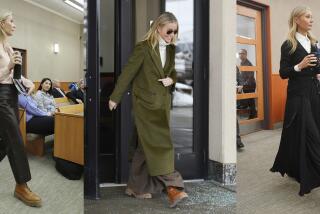Discount e-tailer still hopes for buzz
- Share via
In the wake of the tech stock downturn six years ago, online retailers were dropping like flies, and designer fashion site Bluefly Inc. looked as if it would join them.
After all, the New York company hadn’t turned a profit since its 1998 launch. It still hasn’t. This year the stock fell so low that Bluefly was warned it might be delisted by Nasdaq.
But this feisty e-tailer, which promotes itself with television ads so racy that most traditional broadcasters won’t carry them, has managed to hang on for yet another Cyber Monday, today’s annual kickoff of the holiday buying season online.
Chief Executive Melissa Payner -- who overhauled the company since joining it three years ago and raised funds from investors to keep it going -- says the time is right for Bluefly’s strategy of providing bargains on Armani, Prada and other high-style labels.
“We went through all those years when people wanted to brag about their jewels and their expensive clothing,” Payner said. “And people still want those things they see on celebrities.
“The difference is that now, if you tell a woman she has a great handbag, the first thing she might say is, ‘You won’t believe what I paid for it.’ She wants you to know she’s an intelligent shopper.”
Payner, 48, said that when Bluefly was launched it was not choosy about the items it got from designers.
“They would take almost anything in order to say that the designer was on the site,” she said. “They ended up with last year’s styles, clothes that didn’t fit well, stuff the designer was stuck with.”
Payner, who had been president of apparel retailer Chico’s and chief executive of the Spiegel catalog company before coming to Bluefly, transformed its way of acquiring designer clothes and accessories.
Her buyers hit the marketplace daily to buy in-season fashions. They would get the leftovers at a price break from what front-line retailers, such as major department stores and boutiques, would pay months before the season began.
“We’re very selective,” Payner said. “We might miss out on some stuff, but we don’t feel we miss out on trends. We’re on season.”
The designers, meanwhile, get cash flow outside the usual buying period. That offsets at least some of the possible stigma of appearing on a discount site.
“It’s just part of doing business these days,” said Los Angeles designer Alan Schwartz. Clothes from his ABS line appear on Bluefly.
“The only thing is that the timing is different, which gives them a price edge. They are not bottom fish.”
Schwartz feels no stigma, he said. “I don’t worry about it. A lot of that is ego.”
Bluefly now sells items from about 350 brands of clothing and accessories. The customer discount can reach 40%.
To get the word out about the site, the company embarked on an advertising campaign last year known as Nothing to Wear. Literally.
The television ad began with a woman shown from the shoulders up looking around her closet and deciding she had nothing to wear for a party at her own house. Finally, she walks down the hallway nude -- seen from behind -- and into the party. Her guests are flabbergasted.
The ad also shocked most broadcasters, who wouldn’t air it. The ad ran mostly on cable.
“I wanted to push the envelope,” Payner said. “A shock value, with something that is sexual and provocative, gets people curious.”
An ad that debuted in September shows a couple dressing for a concert with fashions from Bluefly. They look at each other and then start removing their clothes.
No nudity this time, but none is needed.
Payner said the ads were a major contributor to sales growth. In the third quarter of this year, sales were $16.3 million compared with $12 million during the same period in 2005, before the first ad ran.
But the higher advertising and marketing budget this year -- at $13 million, more than double that of 2005 -- helped widen losses. In the third quarter, the loss was $3.5 million, compared with $1.7 million a year earlier.
Because Bluefly exists exclusively online it can get a clear and quick reading of how a specific ad can affect business.
“When we first showed the Nothing to Wear ad during ‘Sex and the City,’ we saw at the end of the commercial our traffic spiked right away,” Payner recalled.
“We knew our customers were sitting with their laptops, multi-tasking.”
Investors, however, have been wary. In the last year, shares of Bluefly fell nearly 35% and lately have been hovering below $1.
Analyst Charles Carlson, who edits the DRIP Investor newsletter, wasn’t optimistic. On his rating scale for stocks, which ranges from 0 to 100 based on financial information, he gave Bluefly a 3.
“There is not much to like here,” Carlson said. “The stock price performance is pretty dismal and they have a tendency to burn cash.
“At some point their survival will depend on the generosity of others to fund it.”
Two investment companies -- Maverick Capital and Prentice Capital Management -- did just that in June. They each poured $25 million into the company, helping to fund Bluefly’s revised marketing strategy and advertising scheme.
Maverick and Prentice executives didn’t respond to requests for comment.
Now the site has to lure more dollars from shoppers to beat the odds for major e-tailers that don’t have store or catalog sales -- and don’t happen to be Amazon.com.
“You have to consider that we’re like a new business with a new strategy,” Payner said. “We have to prove that it’s executable and repeatable.
“And that takes time.”
*
More to Read
Inside the business of entertainment
The Wide Shot brings you news, analysis and insights on everything from streaming wars to production — and what it all means for the future.
You may occasionally receive promotional content from the Los Angeles Times.











